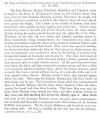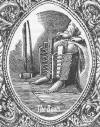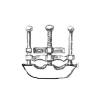|
The
Revenge of Charles II – the Restoration 1660-1688.
The return
of Charles II from exile in 1660 began a period that Macaulay termed “the reign of saints to be succeeded by the reign of strumpets.” What in fact it became was a reign of revenge
as Charles persecuted those who had so badly treated him in the
short period of his earlier return to Scotland (1649 –
1651). Early action was taken against James Guthrie, the
Marquis of Argyll who were both soon executed, to be
followed later by Archibald Johnstone, Lord Warriston.
The approval for a new Parliament is recorded in Nicolls Diary, but the populace`s joy was short lived. It was summoned in 1661 and a
resolution (17 May 1661 ) passed that the Covenant should be
publicly burned and a Bill that declared the “Solemn
League and Covenant” illegal ( 30 May 1661) created panic. Within days there were moves to reconstruct the church which prompted hurried meetings of Synods and drafting of petitions. These were in some cases rejected, or simply ignored, and quite possibly sowed the seed for more action against the church. Convocations were declared illegal gatherings and dissolved; bishops were appointed ( the hierarchy of Fairfull, Leighton, Hamilton and Sharp having been consecrated in Westminster Abbey on 15 December 1661 – text image below)). The bishops designate were consecrated at Holyrood Abbey Church on Wednesday 7 May 1662, the following day nine of the fourteen new prelates took their seats in Parliament. The scene was now set for an attack on Presbytery.

The second session of Middleton`s parliament sat from 8 May until 9 September 1662. Its first act being the restoration off the “antient constitution, and that the clergie have their place and vote in parliament as formerlie”. This session saw the removal of many hard won acts removed from the statute book and new legislation that was `unacceptable` to the dissenting Presbyterians.
In Scotland
the English Act of Uniformity
1662 was mirrored by an Act of 1662 which required all
ministers who did not have a bishop`s licence to be
presented by a patron and accept collation (approval) by a
bishop. Subsequent action by the Kings Commissioner,
Middleton, led to the eviction or `outing` of over 300
ministers from their manses. There was also action under
an act of 1663 -“ An Act for Separation and Disobedience
to Ecclesiastical Authority “ – to force attendance
at the parish church which were now held by the curates. Known as the
Bishops Dragnet,` fines were imposed and collected by military force.
In the autumn of 1663 Parliament departed in the knowledge that it was
unlikely to be called again, since management of affairs now passed
to the Privy Council.
An important change in the
hierarchy of the Crown`s servants came with the forced resignation of
Middleton in January 1664 and the appointment of his successor – the Duke
of Rothes. Although more capable then Middleton, he was credited with a
clear judgment and quick to pick up issues. But he was also a wild
debaucher and largely illiterate and as keen as any to fill his own
pocket. It was significant that from the outset his chief adviser was
Archnishop James Sharp. Smellie in Men of the Covenant describes
the duo thus
“Rothes was
extortionate and brutal; the Prelate was revengeful and persistent in his
enmities; with this duumvirate in authority the prospect for the friends
of the Covenant was as gloomy as midnight.”
The use of excessive force
in the collection of fines led to more misery and bloodshed when an
elderly man was seized by soldiers and threatened with torture in Dalry. This gave rise to the Pentland
Rising in which the Covenanters were defeated in a
skirmish at Rullion Green
near Edinburgh in November 1666. Over a 100 prisoners were
taken and many executed as an example to others. The
“duumvirate” of Sharp and Rothes excelled themselves in the speedy
executions, and gloried in having heads and hands lopped off and sent to
the dead men`s home towns for exhibition on church doors and gateways.
Sharp meanwhile convinced the King to reintroduce the obsolete
Court of High Commission for
the summary trial and conviction of recusants. He was made President of
this organ of oppression which became his personal weapon against the
Covenanters.
By 1670 the
land was under military rule with troops billeted among
the people. Increasingly odious laws against
conventicles, the outdoor prayer meetings, were introduced
including the infamous Bond which
required landlords to be responsible for their
tenants, and heads of families responsible for their wives
and children. The widespread refusal to sign the Bond was
responsible for the Highland Host being sent into Ayrshire
and parts of Renfrewshire in January and February 1668. In
1679 Archbishop Sharp was assassinated and the Covenanters
had modest military success against the infamous John
Graham of Claverhouse in June 1679 at
Drumclog. But the Covenanter
army of about 5000 was riven by internal arguements and
defeated at Bothwell Brig by
the Duke of Monmouth. Over 400 were left

dead and 1100 prisoners taken and held in the open at
Greyfriars Kirk Yard for up to five months. Two ministers
were hung and others executed. Some 257 were sentenced to
transportation to the West Indies but their ship, the
Crown, sank in bad
weather off of Deerness in the Orkney Islands and 211 were
drowned. The survivors were later transported in another
ship.
The
methodology of Oppression.
The methods used to persecute and oppress the Covenanters
is almost beyond belief but evidence exists for all the
following :
” butchering, hanging, heading, mangling, dismembering
alive, quartering upon scaffolds, imprisoning, laying in
irons, torturing by boots, thumbkins, fire-matches,
cutting pieces out of the ears of others, banishing and
selling as slaves old and young men and women in great
numbers, oppressing many others in their estates,
forfeiting, robbing, spoiling, pillaging their goods,
casting them out of their habitations, interdicting any to
reset them, under the pain of being treated after the same
manner”.
 
Cruelty was more common then and certainly less condemned than now; but even if the Covenanters had been completely wrong and the government entirely right about all the matters at issue, it is impossible to justify the cruelties perpetrated on the Covenanters, particularly the use of torture, and execution without due process of law.
The two favoured devices were “the boot” which shattered and crushed the lower leg; and the “thumb screws” that could mangle fingers as well as create excruciating pain.
Effects of
Persecution
The effect
of persecution was reflected in substantial migration of
Scots to Ulster minded to settle there if land was
available. It was estimated that about 30,000 went to
Ulster between 1660 and 1690 and the numbers increased
following bad harvests with an estimated 10,000 in 1692
alone. These migrants mostly entered Ulster via
Londonderry and settled in the west of the province.
Ironically the Scottish administration noted their concern
at the exodus fearing that some heritours (landowners)
would be left without tenants.
Another bastion for the exiled and fleeing Covenanters was Holland where there was full Communion with the Reformed Church of Holland and the Scots. There were Scottish churches in Rotterdam, Campvere, Leyden, Amsterdam, Delft, Dordrecht, the Hague and Middleburg. Importantly Scottish probationer ministers were readily received by the Dutch Synod and the local “Classis” or Presbyteries, conferred ordination or induction when required on the ministers elected by the Scottish congregations within their bounds. It was not surprising therefore that the Societies sent Commissioners to Holland or that the likes of Richard Cameron and James Renwick were ordained by Dutch ministers in association with exiled Presbyterians.
Despite
defeats and severe penalties the Covenanters continued to
resist led by such ministers as Donald Cargill and Richard
Cameron, known as “Society Men” and also “The
Cameronians”. A major act of both statement of
principle and an alleged declaration of war, was the
publishing of the Declaration at
Sanquhar on 22 June calling for the removal of Charles
II. Richard Cameron , his brother and Donald Cargill
among others, were subsequently
Proclaimed Rebels and Traitors. Cameron was killed at
Ayrs Moss on 22 July 1680
Famously,
at a conventicle at Torwood in
September 1680, Donald Cargill publicly excommunicated the
King, his sons – James Duke of York (later James II)
and his illegitimate son James Duke of Monmouth; and
the leaders of the government who had been central to the
persecution – the Duke of Lauderdale, the Duke of Rothes,
the Lord Advocate Sir George MacKenzie
and the the `Beast
of Muscovy` General Tam Dalziel of the Binns.
Perhaps it was regarded as a small thing to those named,
or perhaps a stinging riposte; but in the eyes of the Kirk
and the People of God it was the ultimate denunciation and
punishment.
The
strongest and most extreme forms of Covenanting were to be
found in Ayrshire and the south west in Dumfries and
Galloway where dissenting ministers had substantial
congregations. Their resistance took the form of guerilla
tactics and attendance at open air meetings or
conventicles which had members of the congregation who
were armed and prepared to resist the troopers who
searched for them. They were harried with very harsh laws
by a government suspicious of treason, and by heavy handed
military and judicial reprisals, especially after 1681.
The `on the spot ` shootings and hangings reached their
height in `The Killing Time” of 1684-5.
It was no
better for the Presbyterians when James II took the throne
in 1685. James was open in his support for the Mass and
made appointments of Catholics to positions of power which
confirmed the worst fears of the Protestants. Before long
other forces in England led to the call for William of
Orange to take the Crown and the Scots joined them
with an invitation for William to take the Crown of
Scotland. Famously James made an attempt to recover
his position and Crown in Ireland where his siege of
Londonderry failed and the Battle of the Boyne (1690)
finally assured the Protestant succession in Britain. The
settlement gave toleration of Presbyterianism but it was
not the pure church of the Covenanters. Those who
continued to dissent had earlier formed themselves into
Praying Societies and became the Reformed Church of
Scotland in later years.
A parting comment on
Charles II is furnished from Fountainhall`s Historical Notices
wherein he comments on the unveiling of the statue of Charles II in
Parliament Close, Edinburgh in January 1686. The common vulgar people as
he describes them, were nearest the mark in their opinion of Charles II.
“The late King’s [CharlesII’s] statue on horseback, was erected
and set up in the
Parliament Closse. It stood the Toune of Edinburgh
very dear, more then 1000 lb. sterling. Some alledged, It was wrong
placed, with the tayll to the great gate and image of
Justice above the Parliament-[house]
door. He is formed in the Roman manner, like one of the Caesars,
almost naked, and so without spurs and without
stirrups. . . . The vulgar peeple, who
had never seen the like before,
ware much amazed at it. Some compared it to Nebuchadnezar’s
image, which all fell doune and
worshipped; and others foolishly to the pale horse in the
Revelation, and he that sate theiron was Death.”
Over 1100
ministers suffered for their
faith and alleged crimes in the period of the Reformation
1560 – 1690.
Next : The Kirk and
its impact on the people
|